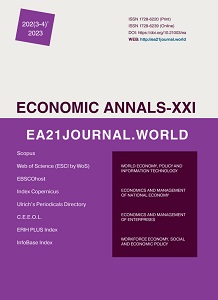Exploring the economic and social relationships in a triadic model of continuous professional development
Exploring the economic and social relationships in a triadic model of continuous professional development
Author(s): Kulzhanat Bulatbayeva, Altnai Zhaitapova, Farida Nametkulova, Amangul Orakova, Saule Muhambetzhanova, Manara AdamovaSubject(s): Social Sciences, Economy, Education, Economic policy, Human Resources in Economy, Socio-Economic Research
Published by: Institute of Society Transformation
Keywords: Continuous Professional Development; Skill Accumulation; Labor Market Mobility; Kazakhstan; Economic Implications; Triadic Model; Individual Skill Accumulation; Organizational Skill Utilization;
Summary/Abstract: The transformation of labor markets necessitates a dynamic approach to professional development. In Kazakhstan, a country in the throes of economic diversification, the economic implications of Continuous Professional Development (CPD) hold relevance. This paper introduces a triadic model that aims to explore the relationships between CPD, skill accumulation, and labor market mobility within the context of Kazakhstan’s developing economy. We examine the quantitative and qualitative economic benefits and drawbacks associated with CPD initiatives at both the individual and organizational levels. By employing multi-method analysis, which includes statistical modelling, survey data, and case studies, the study presents an intricate understanding of how CPD investments propagate through the labor market, affecting individual career trajectories, organizational competitiveness, and overall economic productivity. The triadic model consists of three interconnected components: Individual Skill Accumulation (ISA), Organizational Skill Utilization (OSU), and Labor Market Mobility (LMM). The ISA component analyses how CPD activities contribute to an individual’s skillset, both hard and soft skills. OSU focuses on how organizations harness these accumulated skills for operational efficiency and market competitiveness. Finally, LMM investigates how CPD-influenced skills affect labor market transitions, including lateral movements, promotions, and even inter-industry mobility. The empirical results indicate a strong positive correlation between CPD investment and skill accumulation, which subsequently influences labor market mobility in both intra- and inter-industry contexts. Organizations participating in CPD initiatives were found to have a competitive edge, particularly in technology adoption and human capital retention. However, the benefits are not unequivocally distributed, with the upper echelons of organizational hierarchies reaping disproportionate advantages. Moreover, a lack of standardization in CPD programs may contribute to a skills mismatch, thus countering some economic benefits. This paper contributes to the extant literature by providing a nuanced view of CPD’s role in a developing economic context. Policymakers and organizational leaders can leverage these insights to formulate more effective CPD strategies that align with broader economic goals and societal needs.
Journal: Економічний часопис - ХХІ
- Issue Year: 202/2023
- Issue No: 03+04
- Page Range: 96-107
- Page Count: 8
- Language: English

